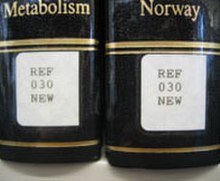The Dewey Decimal Classification (DDC, also called the Dewey Decimal System) is a proprietarylibrary classification developed by Melvil Dewey in 1876; it has been greatly modified and expanded through 22 major revisions, the most recent in 2003.[1] This system organizes books on library shelves in a specific and repeatable order that makes it easy to find any book and return it to its proper place. The system is used in 200,000 libraries in at least 135 countries. system of
Design
The DDC attempts to organize all knowledge into ten main classes. The ten main classes are each further subdivided into ten divisions, and each division into ten sections, giving ten main classes, 100 divisions and 1000 sections. DDC's advantage in using decimals for its categories allows it to be both purely numerical and infinitely hierarchical. It also uses some aspects of a faceted classification scheme, combining elements from different parts of the structure to construct a number representing the subject content (often combining two subject elements with linking numbers and geographical and temporal elements) and form of an item rather than drawing upon a list containing each class and its meaning.
Except for general works and fiction, works are classified principally by subject, with extensions for subject relationships, place, time or type of material, producing classification numbers of at least three digits but otherwise of indeterminate length with a decimal point before the fourth digit, where present (e.g. 330 for economics + .9 for geographic treatment + .04 for Europe = 330.94 European economy; 973 for United States + .05 form division for periodicals = 973.05 periodicals concerning the United States generally).
Books are placed on the shelf in increasing numerical order of the decimal number, e.g. 050, 220, 330, 330.973, 331. When two books have the same classification number the second line of the call number (usually the first letter or letters of the author's last name, the title if there is no identifiable author) is placed in alphabetical order.
The DDC has a number for all books, including fiction: American fiction is classified in 813. Most libraries create a separate fiction section to allow shelving in a more generalized fashion than Dewey provides for, or to avoid the space that would be taken up in the 800s, or simply to allow readers to find preferred authors by alphabetical order of surname.
Some parts of the classification offer options to accommodate different kinds of libraries. An important feature of the scheme is the ability to assign multiple class numbers to a bibliographical item and only use one of them for shelving. The added numbers appear in the classified subject catalog (though this is not the usual practice in North America). For the full benefit of the scheme the relative index and the tables that form part of every edition must be understood and consulted when required. The structure of the schedules is such that subjects close to each other in a dictionary catalog are dispersed in the Dewey schedules (e.g., architecture of Chicago quite separate from geography of Chicago).
Classes listed
Main article: List of Dewey Decimal classes
The system is made up of ten main classes or categories, each divided into ten secondary classes or subcategories, each containing ten subdivisions.
.jpg)


